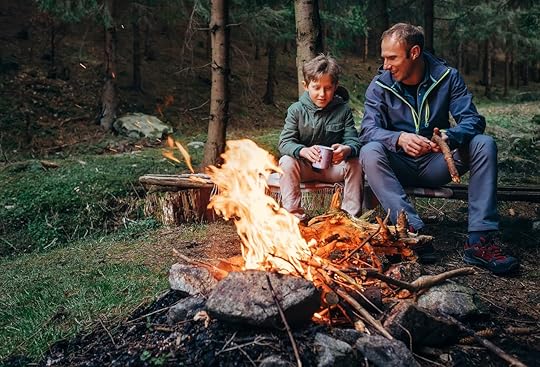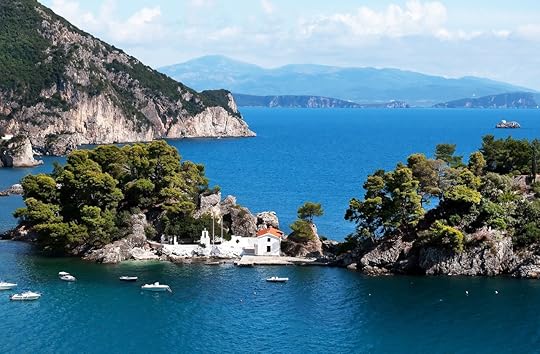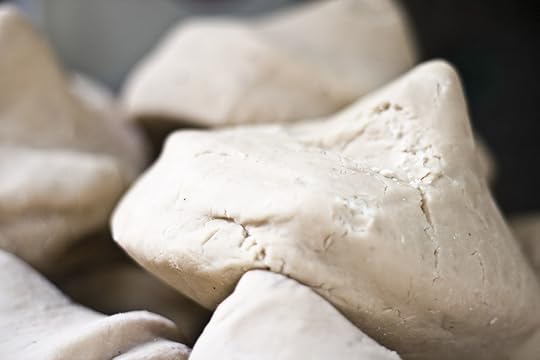Matador Network's Blog, page 843
June 9, 2020
How to properly put out a campfire

Data can be startling, particularly with regards to destruction. Wildfires, responsible for the burning of more than 10 million acres of open land in the United States in 2015, are a massive problem that is only amplified by climate change, habitat ruin, and an increasing number of people recreating outdoors. Even more shocking is that a full 84 percent of wildfires are caused by humans, according to a University of Colorado study.
Here’s another banger, this time from the Insurance Information Institution: From January 1 to June 2, 2020, there were 19,762 wildland fires in the US. Over the same period in 2019, that number was significantly lower — 14,969 wildland fires — which still seems like a lot given how easy it is to not start a fire.
Sitting around a campfire is one of the most satisfying parts of spending a night in the woods — the food, the songs, the awkward stories that you half-believe. Huddling in the dark just isn’t the same. But not completely extinguishing the fire before going to bed is the easiest way to ruin camping for everyone.
At the risk of sounding too much like Smokey Bear, come on, people.
First, don’t start a fire when you shouldn’t
Before we discuss how to put out a fire, note that there are times when you should never start one. The most obvious is by not tossing your cigarette butts on the ground. And remember that hot ashes from cigarettes and other smokeables can start a fire. In fact, cigarettes are the number one cause of death by fire in US homes. Besides that, cigarette butts are trash, and should be disposed of accordingly.
Second, fire bans — including fireworks — are there for a reason, and that reason is not to specifically hamper your fun. If a fire ban is in place, that’s usually because experts have determined that weather and brush conditions are too dry to have one; you could be camping in one big tinderbox.
We can hear some of you saying, “Liberty uber alles! If I want to start a fire or blow up cheap combustibles to produce a really loud noise, the guv’ment can’t tell me not to. It’s tradition!” Thing is, yes it can. Hark the current COVID-induced, mask-wearing situation. Your liberty guarantees you the right to freedom of movement, choice, and action — as long as no one else is endangered by your decision-making.
The website Fire Restrictions notes all current fire restrictions in the US on a handy map, making it easy to note whether you’ve selected a campsite where a fire is permitted. When campfires are allowed, put it out completely before going to sleep. Here’s how to do just that.
How to properly put out a campfire

Photo: Sundays Photography/Shutterstock
Step 1: Apply a firm blanket of water.
This is the straightforward part. Apply ample water to the fire ring, even if the fire is dwindling down to embers. When you first apply water to the campfire, there will be smoke and sizzling. You’re not done applying water until both have stopped. If you don’t have enough water on hand to complete the task, take a bucket, bowl, or set of cups down to a nearby stream or lake. Cheap light beer is pretty much water, so yes, that also counts.
Step 2: Add soil and stir.
This task can be given to the person who didn’t do any of the work involved to cook dinner. Grab a few handfuls of dirt from around the fire ring and add it to the embers. Then, take a sturdy stick and stir it around to create a sort of earthy broth. Everything in the ring should be dampened, creating a pile of debris that’s as appetizing as the first time you laid eyes on a bowl of oatmeal.

Photo: mediandrew/Shutterstock
Step 3: Touch it.
The remnants of your fire should be cool to the touch. Not necessarily cold and uncomfortable, just tepidly chilled. Add a bit more water just for good measure.
Step 4: Circumnavigate your campsite.
Now that the fire itself has been extinguished, walk around the campsite and its surroundings just to make sure there are no loose sparks. This gives ultimate peace of mind before embarking on the daunting task of properly arranging yourself for a semi-comfortable night’s sleep. It’s also a great opportunity to locate any belongings that may have been scattered by wind or a rowdy fellow camper. 
More like this Camping How to pitch a tent like a pro on your first camping trip
The post How to put out a campfire properly, for newbies appeared first on Matador Network.

Sri Lanka opens to tourism in August

Sri Lanka is planning to welcome tourists back starting on August 1, 2020, but it’s taking this step with a serious safety protocol.
Many countries are now requiring a negative COVID-19 test upon arrival, administering them at the airports, but Sri Lanka is requiring four tests. According to Sri Lanka Tourism, the first test must be taken within 72 hours of your departure to Sri Lanka, and the second will be administered at the airport, on arrival, for free. While you’re waiting for the results — it could take up to 24 hours — you must wait in a hotel in Colombo or Negombo. Assuming you test negative, you will be required to take another test four to five days after arrival via a mobile unit, and if you’re staying longer, yet another test after 10 days.
“While this may be inconvenient,” the tourism website acknowledges, “it is essential to safeguard everybody and provide peace of mind.”
If you do test positive after any of these four tests, you will be placed in quarantine for 14 to 21 days, depending on your symptoms.
In addition to the tests, a tourist visa will now cost $100 (it was previously free), and in your visa application you must provide your itinerary, proof of medical insurance, booking details, and return ticket information.
So yes, visiting Sri Lanka after August will definitely be possible, but you’ll have to be committed. 
More like this Travel The days of US passport dominance may be over
The post Sri Lanka opens to tourists on August 1, but requires four COVID-19 tests appeared first on Matador Network.

Fuji suspends sale of police bikes

Every industry is being asked to engage themselves in the combat against institutional racism in the United States, and that even includes the companies manufacturing police bikes.
After footage surfaced of a New York police officer using his bike to push back protestors, and additional reports of officers using bikes as makeshift riot shields and weapons, Fuji Bikes is suspending the sales of its police bicycles in North America.
LOOK AT HOW THIS NYPD OFFICER IS USING HIS BIKE TO COMBAT PROTESTERS!!! THIS IS INHUMANE. HE IS USING HIS BIKE AS A WEAPON. THIS FROM TODAY @ UNION SQUARE. pic.twitter.com/xhW2S3oEHH
— BABY PAW (@CMONMYBOY) May 29, 2020
Claiming that the bikes are not being used for their intended purpose, the company said in a statement, “We have seen instances in the last week where police have used bicycles in violent tactics, which we did not intend or design our bicycles for. We had always viewed the use of our bicycles by police, fire, security and EMS as one of the better forms of community outreach. Community police on bikes can better connect with and understand the neighborhood, facilitating positive relationships between law enforcement and the citizens they are sworn to serve and protect.”
View this post on InstagramA post shared by Fuji Bikes (@fujibikes) on Jun 5, 2020 at 12:10pm PDT
Trek Bicycles has also come under fire, after a video of Miami’s Bike Response Team demonstrated how police used their bikes to create a barrier in front of protesters.
EXCLUSIVE: “These officers are the elite of the elite”.
A look at @MiamiPD’s Bike Response Team- a specialized unit deployed to handle large crowds and protests. I’m LIVE at 6 on @nbc6 pic.twitter.com/4ejZk1w0iV
— Jamie Guirola (@jamieNBC6) June 4, 2020
But Trek’s response to the protests and the use of its products, unlike Fuji, was deemed meek and not engaged, drawing criticism.
A statement from John Burke: https://t.co/3LCqB2rXht pic.twitter.com/zH5164XP2H
— Trek Bicycle (@TrekBikes) June 2, 2020
More like this News How to support Black Lives Matter protests if you can’t be there in person
The post Fuji suspends sales of police bikes after videos show their misuse during protests appeared first on Matador Network.

June 8, 2020
Philippine Airlines baby delivery

Flight attendants have to deal with a lot of situations that aren’t exactly part of the job description. Between rowdy passengers and unattended children, flight attendants are asked to serve as bouncer and babysitter, all while they carry out their regular duties. Now, you can add delivery room doctor to that list. Over the weekend, flight attendants on a Philippine Airlines flight helped deliver a baby aboard a repatriation flight from Dubai to Manila.
Guided by a doctor via satellite phone, the cabin crew helped birth a baby boy at 30,000 feet. Decked out in personal protective equipment, the flight attendants turned a nerve-wracking and potentially dangerous experience into a memorable moment.
Following the successful and unconventional birth, the cabin crew posed with the mother and newborn boy for photos.

Photo: Dino Antigua Karganilla via Cielo Villaluna’s Facebook Page/Facebook

Photo: Dino Antigua Karganilla via Cielo Villaluna’s Facebook Page/Facebook
Cielo Villaluna, a spokesperson for Philippine Airlines, said of the flight attendants’ teamwork and preparedness, “This was the winning formula which enabled the cabin crew team of a PAL Manila-bound flight from Dubai (PR659/June6) to successfully bring into this world a healthy baby boy. PAL crew is trained to deal with these inflight moments. An extraordinary situation.” 
More like this Airports + Flying Flight attendants confess things like sex on planes and watered-down drinks in a new survey
The post Philippine Airlines cabin crew helped passenger give birth mid-flight appeared first on Matador Network.

Treasure found in Rocky Mountains

In these tough economic times, finding a hidden treasure chest on a casual afternoon hike would be pretty clutch, and that’s exactly what happened for a lucky hiker over the weekend.
Last week, someone found a bronze treasure chest hidden deep within the Rocky Mountains since 2010. The chest — filled with gold coins and nuggets, gems, and artifacts — was hidden in the mountains by Santa Fe millionaire Forrest Fenn.

Photo: The Thrill of the Chase/Facebook
Fenn is an art and antiquities dealer who has spent his life collecting paintings, art, trinkets, etc. With the treasure chest, he wanted to spread the joy of hunting treasures out in the wild to someone else. He hid the chest somewhere in the Rocky Mountains of New Mexico, Colorado, Wyoming, or Montana and wrote a poem containing nine clues that served as a treasure map.
It is estimated that more than 350,000 people looked for the chest containing $1 million worth of riches in the past 10 years. According to Fenn, it is a man from “back East” who found the chest. He wants to remain anonymous, but he did send a photo to Fenn to confirm the discovery. The exact spot where the treasure was buried will also remain a secret.
The following is the original post from Fenn, confirming that the treasure has been found: “It was under a canopy of stars in the lush, forested vegetation of the Rocky Mountains and had not moved from the spot where I hid it more than 10 years ago. I do not know the person who found it, but the poem in my book led him to the precise spot. I congratulate the thousands of people who participated in the search and hope they will continue to be drawn by the promise of other discoveries. So the search is over. Look for more information and photos in the coming days.”
Over the past decade, the mystery has been fodder for adventurous treasure hunters seeking riches. Some even perished in their attempts. 
More like this Art + Architecture 7 historic treasures destroyed in wars that travelers will never get to see
The post A treasure chest hidden in the Rocky Mountains for 10 years has been found appeared first on Matador Network.

Greece summer 2020 travel

Greece is ready to accept travelers again, and its deft management of the COVID-19 crises should put it at the top of places to consider visiting this summer. As of this week, Greece counted fewer than 3,000 coronavirus infections and just 180 deaths, nearly the lowest per capita rate in Europe.
Few would have expected a country going through a decade of debt to set such an admirable precedent in pandemic management. Greece’s outperformance can be attributed to a combination of causes, but the country’s drive and efforts to contain the spread of the coronavirus leap out. Greece promptly shut down areas of public life that could be avenues for transmissions and quarantined all arriving travelers for two weeks. And until the beginning of May, Greek citizens stayed at home dutifully with a collective motivation: to shield Greece’s megalithic industry, the sacred Greek summer.
Now, Greece looks set to be one of the smartest travel choices of the summer, especially if you explore Greek destinations you never knew existed. Here’s what to expect when traveling to Greece and experts’ advice on where to go.
Yes, the Greek summer of 2020 will be different — but it can still be stupendous.
Greek travel experts are optimistic.
We spoke with Tina Kyriaki, founder of Alternative Athens, a local organization offering travel experiences in the heart of which are discovery and human relationships.
Kyriaki and her team say they are ready to welcome visitors from all parts of the world, but she isn’t delusional. She is aware that this summer will be shorter, with the majority of international tourists not expected to arrive in Greece before August.
“We, like all businesses around us, have adapted to the new conditions and are well prepared to attend to travelers. Greece is an ideal post-pandemic destination not only because the spread of coronavirus is contained but also because it has so many places where crowding can be avoided without having to compromise natural beauty, variety of activities, and fresh food and hospitable locals,” said Kyriaki.
We asked Kyriaki if she can identify a positive in the COVID-19 crisis, and she sounded genuinely hopeful. “Travelers will benefit from more humane travel experiences with smaller groups and higher quality services. Also, sought-after cities, especially in Europe, will now have time to recover from the detriments of over-tourism.”
“It is a rare opportunity for someone to visit Greece this summer because they will encounter a uniquely relaxed and undisturbed experience,” said Kyriaki.
Who can travel to Greece

Photo: Haluk Cigsar/Shutterstock
Greece is gradually opening to international flights following a three-tier policy. Currently and until June 15, flights from the EU with passengers undertaking essential travel are allowed into Athens International Airport. Travelers are tested for coronavirus upon arrival and are placed free-of-charge at a designated hotel for one night. If the test is negative, they are required to self-quarantine for seven days. If the test is positive, passengers will undergo a two-week-long quarantine under supervision.
On June 15 the Thessaloniki Airport will start welcoming international flights as well. Between June 15 and June 30, passengers coming from high-risk airports (including Heathrow, Gatwick, São Paulo, Ontario, all airports in Virginia, Florida, California, Michigan, New York, and 18 more states) will be tested upon arrival, following an overnight stay at a designated hotel and the already mentioned quarantine protocol. Comers from airports that aren’t on the European Union Aviation Safety Agency’s list are subject to random tests upon arrival.
From July 1 onwards, international flights are allowed into all Greek airports, and visitors are subject to random tests upon arrival. It’s not yet clarified, but additional restrictions regarding arrivals from certain airports may be implemented.
Traveling to and from Greece
As part of the European Union, Greece adheres to the European Union Aviation Safety Agency (EASA) responsible for a risk-free, end-to-end journey. Not every traveler is an adept organizer, but this is a time when there’s an urgent appeal for planning. This is not a time to arrive at the airport at the last minute. To avoid inconveniences during an already stressful attempt, you are required to arrive at the airport with enough time to spare since the current procedures are out of the ordinary. You are strongly advised to complete the statement of health before checking-in, have enough face masks for the time spent at each airport and the entire flight or flights, and limit your movements in the airport and the cabin.
At the Athens International Airport

Photo: Tony_Traveler85/Shutterstock
We spoke with a representative from the Athens International Airport to obtain the latest and most accurate information, and the numbers we were shown speak louder than words. In May 2019, 2.3 million people passed through Athens’ airport, whereas this year, the number is as low as 84,000. Yet, the goal is for people to get back to air traveling and for the aviation industry to reestablish itself as one that offers safe, high-quality services.
Athens International Airport, which has been selected by EASA and the European Centre for Disease Prevention & Control for its airport hygiene pilot program, meticulously observes the rules concerning hand washing, sanitizing, using face masks, and physically distancing. If you worry about hygiene standards, bear in mind that entrance in the building is permitted to ticketed passengers only, the use of face masks is obligatory, over 300 sanitization spots are available at the airport’s premises, and the air conditioning system is filtered and maintained regularly. Enhanced aircraft disinfection for mitigating risks of coronavirus transmission is applied on aircrafts operating from high-risk airports.
Remember that sanitizers and hand gels are exempt from the liquids’ regulation and are allowed in hand luggage even if the container is over 100 milliliters. Also, as part of preventive measures, airline lounges are currently closed. For more information regarding the airports’ operations, you can call Greece’s 24-hour line on +30 210 3530000.
Public transport in Athens
All public means of transport (buses, metro, suburban rail, and national buses) are currently operating. To encourage commuters to continue using public transport, the cost of transportation in Athens has been reduced, and the lower prices will be valid until the end of October. For example, the standard 90-minute ticket valid for all means has dropped from 1.40 to 1.20 euros. The 24-hour ticket now costs 4.10 euros, and the five-day ticket costs only 8.20 euros. The airport metro ticket is one euro cheaper than before the coronavirus outbreak, bringing the price down to nine euros, and the return airport metro ticket has dropped to 16 euros from 18.
Travel to the islands by ship
Currently, Greek shipping companies operate with 50 percent of their capacity, a measure that’s expected to be in place until the end of June. From the 85 ships, only 35 are operational with sporadic routes to the islands, but the number of routes will rise depending on the demand.
If you are planning to board a ship, you should keep in mind that health workers will measure your temperature before boarding, you will have to fill out a form with your personal information, and keep the 60-inch distance at all times in the vessel. If you book a cabin, note that only one person is allowed per cabin unless you travel with first-degree relatives.
More like this Beaches + Islands The best islands you can day trip to from Athens
Αrchaeological sites and museums are open
The Acropolis, Ancient Roman Agora, Temple of Poseidon, Site of Olympia, Mycenae, Theatre of Epidaurus, Delphi, Delos Unesco World Heritage, Palace of Knossos, and over 200 more Greek archaeological sites are fully operational at the time of writing.
Archaeological sites are open to visitors from 8:00 AM to 8:00 PM following the necessary hygiene measures. Museums, such as the Acropolis Museum, will open from June 15 along with spa services and thermal baths in water springs in Loutraki, Ikaria, and Edipsos.
Greece’s little-known, hidden destinations without crowds

Photo: stoyanh/Shutterstock
In his blog, The Greek Traveller, travel journalist and cartographer Antonis Iordanoglou talks about two Greeces: the touristy and authentic Greece.
“The ongoing pandemic will profoundly affect people’s travel behaviors, especially this summer. Safety and hygiene factors will determine holiday destinations, and unlike previous years, popular islands will not monopolize the summer scene. Perhaps the ‘other’ Greece, where the fear of a COVID-19 outbreak will not be as prevailing pops at the top of travelers’ preferences,” Iordanoglou said.
But where is this real Greece that so many of us don’t know? Iordanoglou suggests forgetting places where we arrive by boat or plane. “Take the road and head inland!” he suggested.
Iordanoglou also recommended seaside destinations along Greece’s westerly shores a few hours’ drive north of Athens, saying, “Along the coast of Epirus, from Astakos to Preveza and from Preveza to Sivota, you will encounter wonderful sandy beaches, whose charm lies in being away from cosmopolitan hubs. On the way are comfortable guest houses, local taverns, and a wealth of natural beauty.”
Another lesser-known place to enjoy Greek beaches is due east of Greece’s second city, Thessaloniki, along the upper reaches of the Aegean Sea. “The pristine coast of Thrace, from Abdera to Maronea [are] reminisces of Greece of the 1950s,” said Iordanoglou.
“It will be a bizarre summer of physical distancing. However, the essence of Greek hospitality will be present. So, come with your heart open to experience a different yet captivating Greece,” said Iordanoglou, when asked about advice to give international travelers thinking of visiting Greece this summer. He added, “Allow yourself to go beyond the stereotypes of your travel guide, and search for those elements that most tourists have ignored over time. This summer, extroversion, beach parties, and holiday acquaintances may be sparse, but the situation favors introspection, discovery, and reflection.” 
More like this Trip Planning The Peloponnese belongs on your must-visit list in Greece
The post Greece is open to travelers, and it may be your best summer option appeared first on Matador Network.

Indian cheeses beyond paneer

If you’ve enjoyed Indian food in the United States, it’s likely that you’ve come across paneer. This soft cheese doesn’t melt and appears in curries and biryani as white cubes that are similar in appearance to haloumi or queso blanco. If that’s where your knowledge of Indian cheese ends, though, you have a lot of learning to do.
In India, cheese might not exactly be common, but the varieties that do exist are diverse in flavor and texture — and they come from all over the country, from Bengal to the Himalayas. One variety is so tough that it can be chewed slowly like gum while another more rare variety has an aromatic smoky flavor. Many others are the basis for sweets sold by street vendors all over India. In fact, the foundation of some of the most beloved desserts in India — from sandesh to gulab jamun — is creamy, tangy, salty cheese.
Here are five types of cheeses any connoisseur of Indian cuisine should know about.
1. Chhena

Photo: Rudra Narayan Mitra/Shutterstock
These cheese curds are made by adding lemon juice to water buffalo or cow’s milk. While paneer is pressed into cakes or cubes until it becomes waterless, chenna is moist and crumbly. Chhenna is especially popular in Bangladesh and the Odisha region of India, where it’s most commonly used to create desserts like rasgulla (chhena dumplings cooked in syrup pictured above). Chhena poda is another popular cake-like dessert of baked cheese flavored with cardamom, raisins, and cashew nuts. Chhena is also the basis for sweets called sandesh, made from condensed milk and jaggery (a type of cane sugar), which is often molded into shapes like fish and elephants.
2. Kalari
Popular in the Rajouri, Poonch, and Udhampur regions of India, as well as in Kashmir, this stretchy cheese is traditionally prepared in an iron pot and then allowed to sun dry until it solidifies. Sometimes enjoyed as street food in the Jammu region, flattened patties of kalari are sauteed on a hot griddle so that the outside becomes golden and crisp while the inside remains gooey. It can also be wrapped in a piece of kulcha (a type of flatbread) and served with a side of chili chutney dipping sauce.
3. Chhurpi

Photo: lakkana savaksuriyawong/Shutterstock
Sometimes also known as dhurka, this hardened cheese made from yak’s milk is mainly consumed in Himalayan regions, including Sikkim, Darjeeling, and Kalimpong, as well as Nepal and Tibet. Chhurpi is pressed, fermented to give it a tangy flavor, and then dried in bite-sized rectangles. The cheese lasts for years, making it a popular snack among animal herders and outdoor enthusiasts who enjoy long hikes. It’s so tough, in fact, that eating it is sometimes compared to chewing gum. It is sometimes also added to soup or combined with chilis to make chutney.
4. Bandel
This cheese originated in the Portuguese colony of Bandel in the eastern Indian region of Bengal. In the 17th century, settlers in the small village employed local Burmese cooks, to whom they taught Portuguese cheese-making techniques. Today, the cheese is primarily made in Bishnupur, West Bengal, and can be found in markets in Calcutta. First, the cheese curds are separated from the whey (the liquid left over after the milk has curdled), then the curds are molded in a round shape and smoked. The resulting cheese is dry and crumbly in texture. Bandel is well-salted so that it can be preserved without refrigeration over long periods of time.
5. Khoa

Photo: mirzamlk/Shutterstock
The foundation for many Indian sweets, khoa (or khoya) is made by stirring boiled milk until it transforms into a thick paste. Gulab jamun, balls of khoa deep-fried in rose water, and pedha, sweetened khoa flavored with saffron or cardamom, are among its most popular applications. Most khoa cheese is produced in the Uttar Pradesh region of Northern India. There are several different types of khoa cheese, including batti, which is the hardest variety that can be grated; chickna, which is sticky and moist in consistency; and daan-e-daar, which is granular and soft. 
More like this Food + Drink Why true cheese lovers should eat more American cheese
The post 5 Indian cheeses you should try if you only know paneer appeared first on Matador Network.

Statue of slave trader torn down

Just days after protesters toppled Confederate monuments in Richmond, VA, and Birmingham, AL, a slave trader’s statue in Bristol was also torn down.
On Sunday, protesters in the southwestern city of Bristol used ropes to pull down a bronze statue of Edward Colston, a 17th-century slave trader. The statue has been controversial for many years, but the recent global events have thrust it into the spotlight.
When the statue came down, a protester was pictured with his knee on Colston’s neck, emulating the way George Floyd was killed by a white police officer on May 25, 2020. The statue was then dragged through the streets of Bristol and thrown into the harbor.
View this post on InstagramA post shared by 13E (@iam13e) on Jun 7, 2020 at 9:49am PDT
Historian David Olusoga told BBC, “Statues are about saying, ‘This was a great man who did great things.’ That is not true, he [Colston] was a slave trader and a murderer.”
Not everyone agrees with the statue’s demise, however. Home Secretary Priti Patel said the incident “speaks to the acts of public disorder that have become a distraction from the cause people are protesting about. It’s right the police follow up and make sure that justice is undertaken with those individuals that are responsible for such disorderly and lawless behaviour.”
Statues weren’t safe in London, either. As crowds gathered for a Black Lives Matter demonstration in the British capital, a statue of Winston Churchill in Parliament Square was sprayed with graffiti. 
More like this News How to support Black Lives Matter protests if you can’t be there in person
The post Protesters take down the statue of a slave trader in Bristol, England appeared first on Matador Network.

New Zealand free from COVID-19

One country can finally say it’s gone back to normal. Except for border controls, New Zealand has officially lifted all social and economic restrictions after eliminating the coronavirus within its borders. As of today, the country has zero active cases. Public and private events, restaurants, the retail industry, and public transport have all returned to pre-pandemic protocols, and social distancing is now a thing of the past.
In a news conference, Prime Minister Jacinda Ardern said she had danced for joy at the news. “While the job is not yet done,” she said, “there is no denying this is a milestone…Thank you, New Zealand. We are confident that we have eliminated transmission of the virus in New Zealand for now, but elimination is not a point in time, it is a sustained effort.”
New Zealand is expected to introduce a “travel bubble” with Australia, allowing tourism between the two countries, though no timeline has been set.
“We will need to move cautiously here,” said Ardern. “No one wants to jeopardize the gains New Zealand has made.”
To eradicate the virus, New Zealand implemented a 75-day lockdown, which shuttered most businesses and required everyone except essential workers to stay home. 
More like this Wellness What New Zealand did right, and what we can still learn from them
The post New Zealand is free of coronavirus and its prime minister dances for joy appeared first on Matador Network.

‘Safe travels’ stamps for COVID-19

One question will be on the minds of all prospective travelers for the next few months: “Is this safe?” Whether it’s airplanes, hotels, or entire countries, travelers can’t really enjoy a vacation if they’re concerned about being infected by COVID-19. To give travelers peace of mind, the World Travel & Tourism Council (WTTC) has designed “safe travels” stamps, which indicate that a tourism entity is abiding by WHO-issued safety protocols. Anyone involved in the tourism industry, including airlines, hotels, restaurants, tour operators, countries, and more can request to participate in the initiative and be issued a stamp if they follow the protocols.
Gloria Guevara, president of the WTTC, said in a statement, “Now travellers will be able to recognise the businesses and destinations worldwide which have adopted the new set of global protocols that will encourage the return of ‘Safe Travels’ around the world. It will, in turn, help the Travel & Tourism sector to reopen for business and move in a coordinated approach.”
Saudi Arabia, Portugal, Cancun, Barcelona, and Seville are destinations that have already expressed support for the program. 
More like this News Portugal is reopening to tourists from these countries, without a two-week quarantine
The post ‘Safe travels’ stamps will mark destinations you can visit with peace of mind appeared first on Matador Network.

Matador Network's Blog
- Matador Network's profile
- 6 followers



